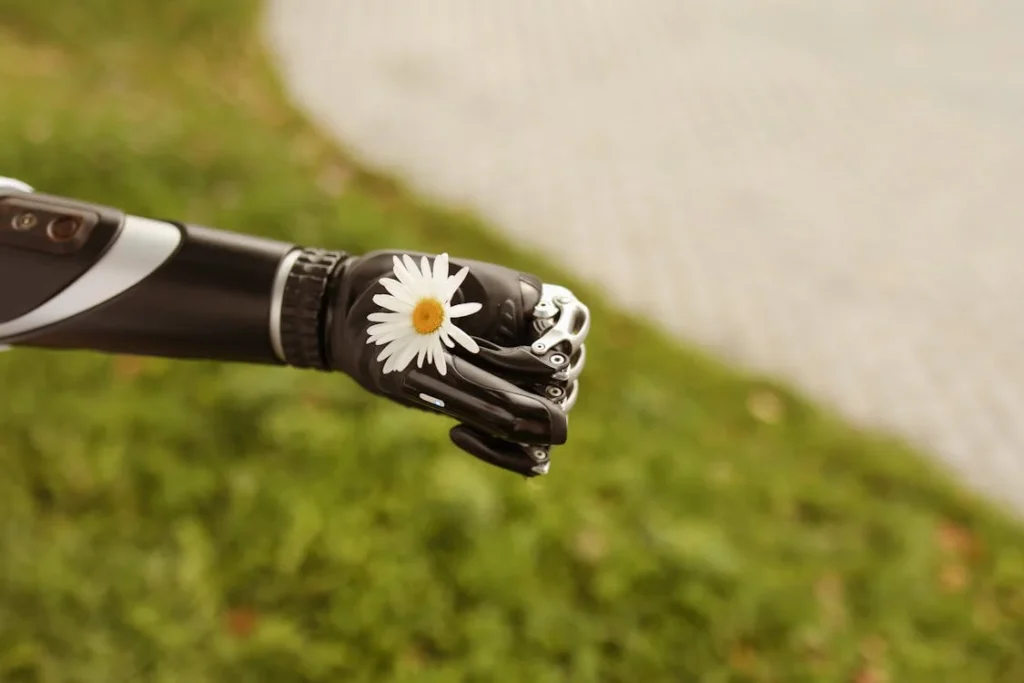Getting back to work after losing a hand is not just a physical journey—it’s emotional, professional, and deeply personal. For many, work is more than a paycheck. It’s part of their identity. It gives structure, purpose, and independence. But when a major life event like limb loss interrupts that rhythm, the path back to employment can feel uncertain and overwhelming.
Thankfully, the rise of modern bionic grips is changing that. These advanced prosthetic hands are doing more than replacing function—they are helping people return to their jobs faster, perform tasks more confidently, and feel like valuable team members again. With every grip, hold, and movement, users are not just working—they’re reclaiming control over their lives.
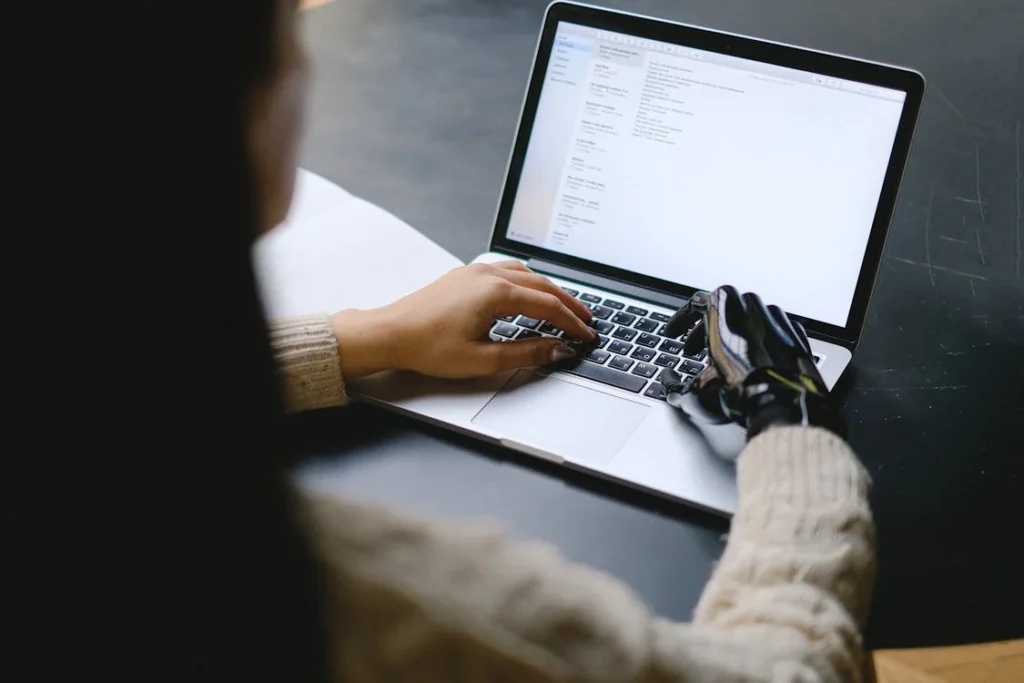
How Bionic Grips Make Workplace Tasks Easier to Handle
What Work Looks Like with One Hand
Every job has its own rhythm. Whether you’re an office worker, a chef, a teacher, a shopkeeper, or an engineer—your hands are involved. Most of us use both hands without even thinking about it. Typing, carrying, holding, opening, writing, lifting, pulling, pushing—these are all tasks that involve coordination between two hands. When someone loses a hand, these once-simple actions can suddenly become daily hurdles.
People with one hand often develop clever strategies to manage. They use their knees to hold objects, lean into tables to open jars, or rely heavily on one side of their body to do double the work. But while these methods help, they often lead to fatigue, muscle strain, and slower productivity. It’s not sustainable—especially in a demanding work setting where speed, efficiency, and accuracy matter.
That’s where bionic grips come in. These advanced prosthetic hands are not just cosmetic replacements. They are functional tools, designed to restore movement and help users engage with their environment in a more natural and efficient way.
Why the Grip Matters More Than We Think
Gripping is a small action with a big impact. The way we hold things—firmly, gently, tightly, loosely—affects everything from pouring a cup of tea to operating machinery. A good grip gives control. And control is exactly what many returning workers crave most after a long recovery.
Bionic grips are designed with this in mind. They can adjust pressure based on what’s being held. A user can grip a fragile object like a glass of water without crushing it. They can also carry a heavy toolbox without worrying about it slipping. This versatility means users no longer have to think twice about simple tasks—they just do them.
At Robobionics, we’ve seen how something as simple as holding a pen or a coffee mug with the non-biological hand can have an enormous effect. It shifts the mindset from “how do I do this?” to “I can do this.” And that’s a powerful mental shift in the workplace.
Reducing the Physical Load on the Body
When one hand is doing the work of two, the body takes a hit. Over time, this leads to strain on the shoulder, neck, and back. The imbalance causes pain, fatigue, and reduced endurance. In work environments that require long hours—whether behind a desk or on a factory floor—this can reduce a person’s ability to perform effectively.
Bionic grips help restore balance. When both sides of the body are active, the physical workload is shared. This not only helps in getting tasks done faster but also reduces the risk of secondary injuries. Users can lift, carry, push, and pull with more confidence and less stress.
And it’s not just about big movements. Even small actions like holding paper while typing, flipping pages, or sealing envelopes become easier. Every task completed with greater ease means more energy saved—and more productivity in the long run.
Real-World Applications in Different Job Roles
Let’s say someone works in an office. They need to type, organize files, shake hands with clients, maybe even give presentations. With a bionic grip, typing becomes smoother as the other hand can help steady papers or adjust screen angles. Presenting becomes more fluid. And small gestures like confidently shaking a colleague’s hand? That brings back a sense of professional pride.
Now think about someone in retail. They’re constantly stocking shelves, handling money, packing items. A responsive grip helps hold items securely, handle cash or a barcode scanner, and even bag goods at the checkout counter—all with less struggle and more speed.
In kitchens, bionic grips help with prep work—holding pots, stirring ingredients, washing vegetables. In workshops, they help with tools—gripping hammers, wrenches, or screwdrivers without slipping. In healthcare roles, they assist with delicate tasks like holding bandages or medical instruments. Across the board, the possibilities are expanding.
And while not all prosthetics are suited for every role, the customization options today mean many users can find a model that fits their unique work environment.
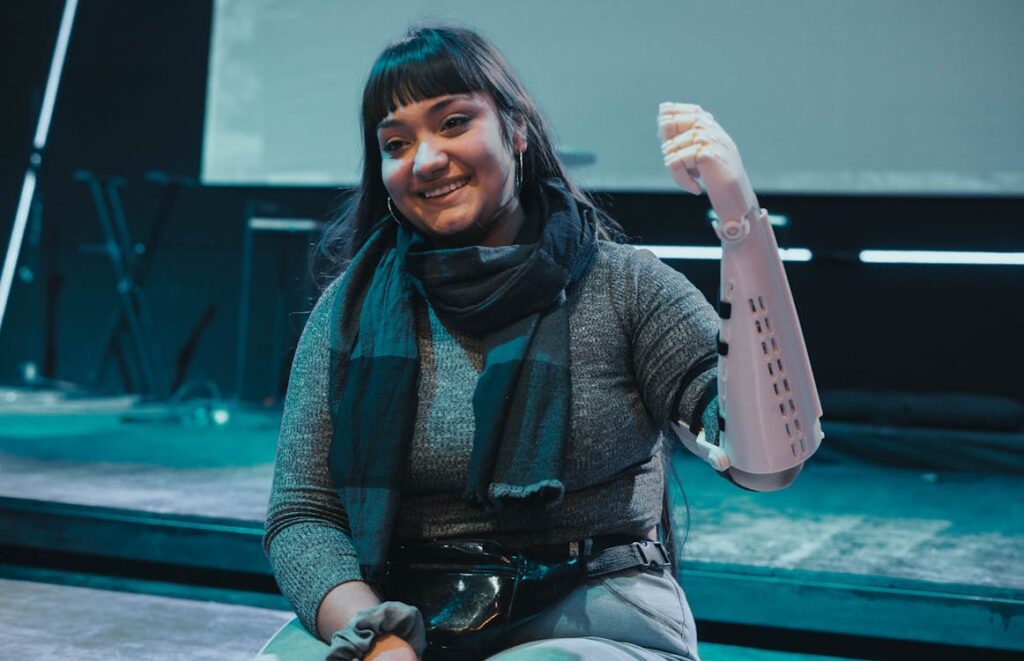
Boosting Confidence and Independence in Professional Settings
Why Returning to Work Feels So Personal
After limb loss, the return to work is about far more than just resuming tasks. It’s about feeling like yourself again. Work, for many people, is closely tied to identity. It’s how they contribute, interact, and find meaning. Losing the ability to perform as they used to can lead to self-doubt and anxiety. There’s often fear of judgment, uncertainty about what can be done, and a quiet worry: “Will I still be good enough?”
Bionic grips help ease that emotional weight. When someone walks back into the workplace with a prosthetic that works and feels intuitive, it changes their entire posture. They no longer have to hide their difference or ask for help with basic tasks.
They arrive ready. Ready to contribute, solve problems, and work with focus. That kind of mindset shift—from “I hope I can manage” to “I know I can do this”—is the true power of technology when it works in harmony with the person using it.
The Subtle Power of Visibility and Interaction
In a professional environment, being seen as capable is critical. But sometimes, even well-meaning coworkers can unintentionally treat a person with a limb difference differently—offering help when it’s not needed, or avoiding certain tasks out of concern. This can make the person feel isolated or underestimated, even when their skills remain sharp.
Bionic grips help break that dynamic. When someone with a high-tech, responsive hand performs tasks smoothly—shaking hands confidently, handling tools with ease, operating machines or writing on a whiteboard—it sends a clear message: “I’m back. I’m capable. I belong here.”
And more often than not, these prosthetics become conversation starters. People ask how they work, express curiosity, and even admiration. This changes the energy from one of awkwardness to one of engagement. It brings people together, builds new respect, and opens doors to better workplace relationships.
Mastering Tasks Means Rebuilding Control
For someone who has been out of work due to injury, trauma, or surgery, life can feel like it’s no longer in their hands—literally and figuratively. They rely on others for things they once did on their own. At work, this might mean depending on coworkers for small things—helping carry equipment, manage files, or handle presentations. Even though most teams are happy to help, constantly asking can make someone feel like a burden.
With a bionic grip, that constant dependence starts to fade. The user begins to take back those tasks. They carry their own materials. They manage their desk setup without assistance. They lift, hold, move, and adjust. These aren’t just actions—they’re choices. And being able to choose how to work, when to do something, or how to handle a situation brings back a strong sense of personal control.
That control doesn’t stop at the physical level. It boosts morale, increases ownership over responsibilities, and sparks the drive to push harder. Because when someone knows they can do the job, they stop worrying about the basics—and start thinking about how to grow.
Improving Focus and Reducing Mental Fatigue
Trying to do everything with one hand isn’t just physically exhausting—it’s mentally draining too. Every step has to be thought through. Tasks that were once muscle memory now require full attention. The result? Faster burnout. For people returning to work, this means slower performance, shorter concentration spans, and more mistakes.
When a bionic grip can take over some of the manual effort, it frees up the brain. The user can focus on the actual work, not the method. Instead of figuring out how to hold something steady or trying to balance a file while typing, they can just get things done.
This mental space makes room for creative thinking, strategic planning, and improved problem-solving—key traits in any job. And over time, the grip becomes second nature. The user doesn’t even think about it. Their attention is back where it belongs: on the work, the team, and their goals.
Earning Respect Through Action
There’s something powerful about doing what others think you can’t. When a person returns to work with a bionic grip and performs not just adequately—but well—they often earn a level of respect that goes beyond sympathy. Colleagues and supervisors begin to see not just the recovery, but the resilience. Not just the technology, but the tenacity.
This shift in perception opens doors. Promotions, new responsibilities, and leadership roles no longer feel out of reach. The user is seen not as someone who overcame difficulty—but as someone who is valuable, resourceful, and deeply capable.
Over time, this also influences company culture. Coworkers become more open-minded. Employers become more proactive about inclusivity. Teams begin to see ability differently. All of that can start with just one person—and one grip—that shows what’s possible.
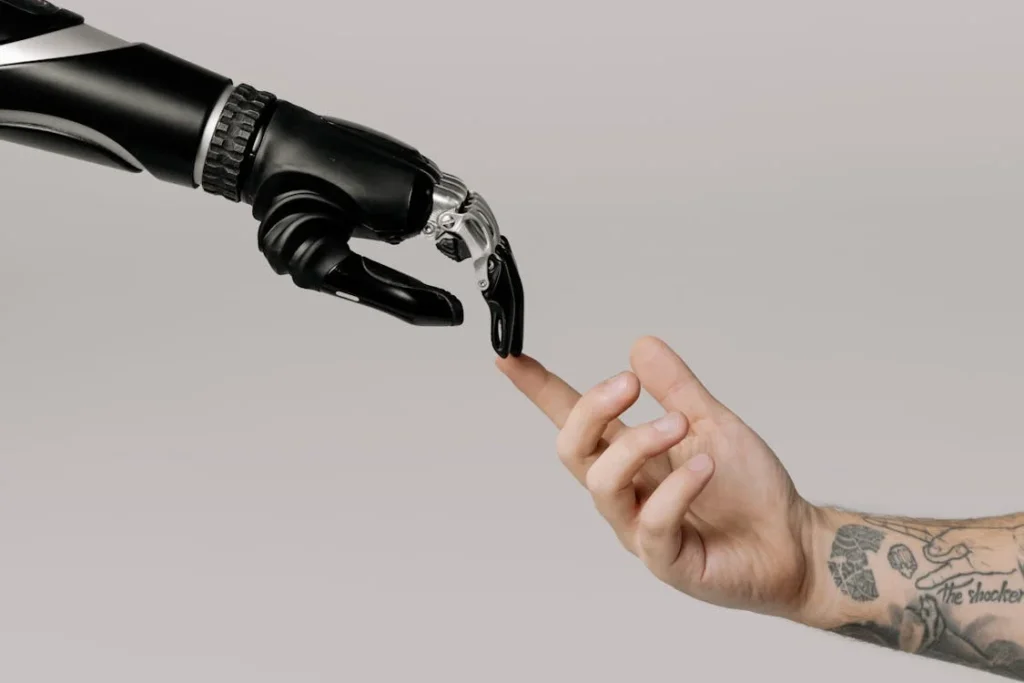
How Employers and Workplaces Can Support Bionic Grip Integration
Creating a Supportive Environment from Day One
Re-entering the workforce with a bionic grip is smoother when employers actively support the process. It’s not just about the physical workspace—it’s about the atmosphere. People returning after limb loss are often full of potential but may still carry worries about how they’ll be received, how others will react, or if their limitations will be misunderstood.
When a workplace offers a warm, understanding welcome, everything shifts. Team members who are informed, managers who are flexible, and HR teams that communicate openly can make the transition not only manageable but genuinely positive. It signals that the company values the person—not just the position they fill.
Support doesn’t have to be complicated. Sometimes it’s as simple as giving the person a little extra time to settle in, checking in regularly, or making sure that tasks are adapted without being stripped of responsibility. These gestures add up. They rebuild trust and remind the employee that they’re still a vital part of the team.
Customizing Workspaces for Function and Comfort
Every prosthetic user has a different way of working. Some may need slightly adjusted desk heights or different keyboard placements. Others may require specific tools or accessories that make daily tasks more manageable. Workplaces that allow employees to personalize their setup show flexibility, which encourages comfort and long-term performance.
Some bionic grip users, for example, may benefit from angled surfaces to help with writing, stabilized trays to prevent items from sliding, or magnetic clips that allow them to manage files more efficiently. None of these changes are expensive, but they have a huge effect on ease and efficiency.
The key here is consultation—not assumption. Employers don’t need to guess what will help. They need to ask. Creating a shared plan, with input from occupational therapists or prosthetists if needed, ensures that support is actually useful—not just well-meaning.
Training and Awareness for Colleagues
Coworkers usually want to be helpful, but they’re often unsure of what to say or do. Should they offer help? Should they ask questions? Should they ignore the prosthetic altogether? These silent questions can create awkwardness or even unintentional isolation for the returning employee.
By offering light-touch awareness training—or even a simple Q&A session—companies can help teams move past discomfort. This allows for open dialogue, honest curiosity, and better day-to-day cooperation. It clears the air and builds a culture of mutual respect.
When colleagues understand how a bionic grip works, they’re more likely to trust the person using it. They’ll feel comfortable delegating tasks, collaborating closely, and treating them as they would any other team member. That kind of normalcy is a huge step toward full inclusion.
Re-evaluating Job Descriptions with Flexibility in Mind
One of the most powerful things an employer can do is revisit the idea of what a role needs to look like. Sometimes, minor tweaks in responsibilities can make a big difference for someone using a bionic grip.
This isn’t about lowering standards. It’s about making smart adjustments. Maybe a task that involves heavy lifting can be swapped with a colleague’s documentation duties. Maybe someone with a bionic hand can use voice tools for note-taking instead of relying on typing for hours. The overall contribution stays the same—the path just shifts slightly.
When job roles are flexible and thoughtfully designed, employees feel trusted. They feel like their employer is focused on what gets done—not how it gets done. That builds loyalty, retention, and long-term engagement.
Measuring Productivity in the Right Way
For someone returning with a bionic grip, the first few weeks or months may be slower. They’re learning to move differently, adjust to new tools, and rebuild their rhythm. Judging performance only by speed or volume in that early stage can be discouraging—and unfair.
Instead, forward-thinking employers look at progress, problem-solving, adaptability, and quality of work. They recognize that learning a new system—especially one involving a prosthetic—is an achievement on its own. With time and training, productivity often returns not just to previous levels, but beyond them. Many users report becoming more focused, more organized, and even more efficient than they were before.
And here’s something interesting: when a company supports an employee’s return in this way, it doesn’t just help one person. It sends a message to the entire team. It shows that people matter. That their growth, health, and challenges are part of the company’s journey—not obstacles to it.
When Inclusion Becomes a Culture, Not a Checklist
Supporting an employee with a bionic grip isn’t about ticking a box. It’s about embracing ability in all its forms. When inclusion becomes part of a workplace’s DNA, amazing things happen. Team dynamics improve. Innovation increases. People bring more of themselves to work—and that creates real value.
We’ve seen businesses transform through the simple act of believing in someone’s potential, despite their challenges. And we’ve seen employees rise higher than anyone expected, all because their workplace believed they could.
So, if you’re an employer, ask yourself: Are we ready to support talent in all its forms? Because with tools like bionic grips, and the right environment, there’s almost no limit to what people can achieve.
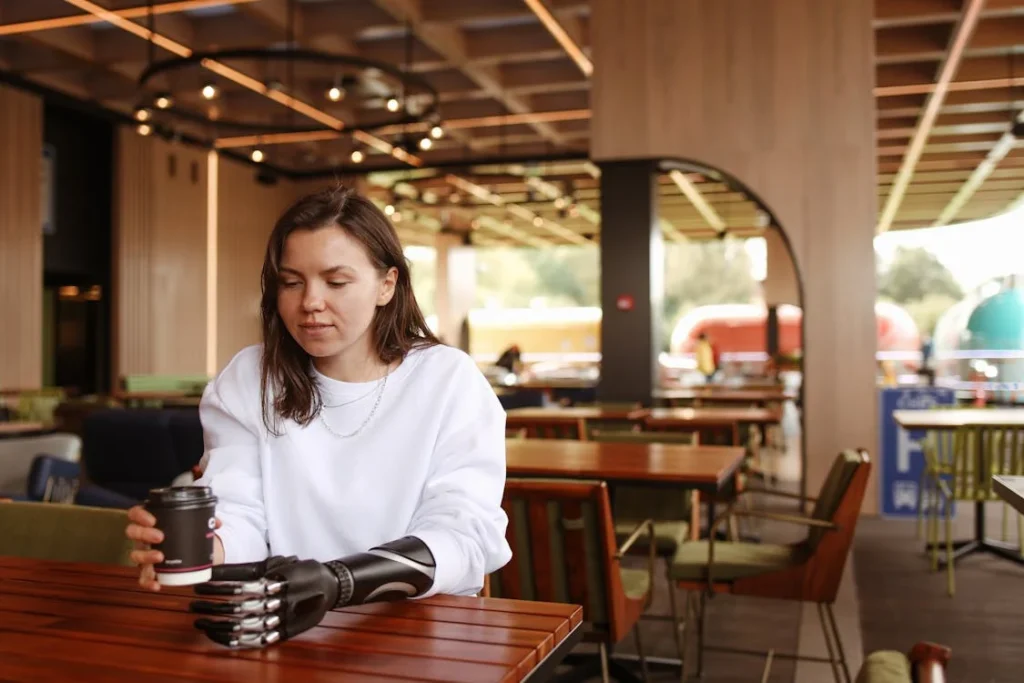
Long-Term Benefits of Bionic Grips on Career Growth and Earning Potential
Why Getting Back to Work Is Only the Beginning
For many people, the first goal after an injury or surgery is simply to get back to work. But what happens after that? What does life look like not just a few months, but a few years into rejoining the workforce with a bionic grip? The truth is—this is where the real power of the technology shows itself.
A responsive, reliable bionic grip doesn’t just help someone do their job today. It helps them dream bigger. It opens doors to new roles, new industries, and new levels of confidence they may never have imagined. With consistent use and continued training, users become faster, more efficient, and more ambitious in their careers. The grip becomes part of how they work—and how they succeed.
At Robobionics, we’ve seen clients start out using their prosthetic to handle daily tasks and eventually move into supervisory roles, management, entrepreneurship, and more. It all starts with the ability to perform—but quickly grows into the ability to lead.
Building Skill, Speed, and Specialization Over Time
Like any tool, a bionic grip becomes more useful the more it’s used. In the beginning, users focus on simple motions—gripping a pen, holding a folder, carrying items. But with time, their control becomes sharper. The grip responds faster. The range of motion becomes more familiar.
This gradual improvement doesn’t just help in the same job—it allows users to take on more complex responsibilities. For example, someone working in graphic design might begin using their prosthetic to assist in tablet work. Someone in healthcare may become more confident in handling medical instruments. In the tech world, a user might operate tools, keyboards, or lab equipment that once seemed out of reach.
This shift from “basic use” to “advanced use” turns a prosthetic from a helpful tool into a real asset. And when a tool becomes an asset, career paths start to widen.
Qualifying for Promotions and Leadership Roles
One of the most significant barriers after limb loss is the fear that career growth will stall. People often wonder: Will I still be seen as capable? Will my manager pass me over for opportunities because they think I can’t handle it physically?
But with a bionic grip in place—and proven performance to match—those assumptions start to break down. Colleagues and supervisors begin to focus on outcomes, not appearances. They see how the grip isn’t a crutch, but a tool for independence. It enhances performance instead of holding it back.
As users master their tools and contribute with consistency, they earn the right to move up. They qualify for training programs. They’re nominated for project leadership. They’re trusted with bigger challenges. And most importantly, they trust themselves more.
Promotion isn’t about perfection—it’s about progress, attitude, and results. A well-used bionic grip helps show all three, clearly and powerfully.
Unlocking New Types of Work and Earning Streams
Let’s talk about income. One of the harsh realities of disability is the financial strain that can come with it. Many people lose their primary source of income after an amputation. Even when they return to work, they may only re-enter part-time or take a lower-paying role due to physical limitations.
But bionic grips can change that equation. By enabling users to return to their original job—or take on new ones with fewer physical limits—they help restore earning power. Some users even find themselves switching industries, taking on freelance work, or starting businesses where their lived experience gives them a unique edge.
In a world where digital tools, online services, and skilled trades are booming, the ability to use both hands—even one biological and one bionic—opens a surprising number of doors. We’ve seen clients move into roles in teaching, content creation, counseling, coding, and even product design—especially in the prosthetics space, where lived experience turns into innovation.
Bionic grips don’t just get people back to where they were—they help them get to where they want to go.
Setting an Example and Inspiring Others
There’s one more benefit that often goes unspoken: the power to inspire. When someone walks into a room with a bionic hand, performs confidently, and leads by example, it sends a strong message—not just to their team, but to others facing similar challenges.
They become proof that life doesn’t stop after limb loss. That careers don’t have to stall. That productivity isn’t measured in limbs, but in results. And in workplaces that are still learning to be inclusive, they become quiet advocates—living, breathing reminders that ability can look many different ways.
That kind of presence builds respect. It shapes culture. And it creates ripple effects that benefit not just the user, but the entire work environment around them.

The Role of Continuous Training and Aftercare in Long-Term Workplace Success
Why Learning Doesn’t Stop After Fitting the Bionic Grip
Getting a bionic grip is a milestone—but it’s not the finish line. It’s the start of an ongoing journey. The true potential of any advanced prosthetic isn’t just in how it works on day one, but how it evolves with the user’s needs, skills, and work environment over time. In the workplace, that evolution is critical.
When someone returns to their job with a new bionic hand, they don’t just need to re-learn how to do tasks—they need to re-learn how they do tasks now. This involves retraining muscle patterns, adjusting work habits, and building new routines that include the prosthetic as a natural part of their body. It’s a mix of physical training and mental reconditioning. And it doesn’t happen in a week.
That’s why ongoing training and support—also known as aftercare—are so important. Without it, users can plateau. But with it, they continue to improve, adapt, and unlock new levels of productivity.
Adapting to Job-Specific Skills and Tools
No two workplaces are the same. A school teacher uses their hands very differently than a chef. A cashier has a different set of tasks than a mechanic. Even within the same industry, roles can vary based on tools, space, pace, and pressure. So, training must go beyond general usage.
At Robobionics, we work closely with users to understand their specific work environments. We look at the exact motions they need to perform—holding markers, using touchscreens, twisting knobs, adjusting delicate objects. We then design training routines that mimic those actions. This could mean practicing with custom props or working side-by-side with occupational therapists to fine-tune grip patterns.
When training is tailored like this, progress is faster—and more meaningful. Users stop struggling with generic movements and start mastering the tasks that matter most to their daily workflow.
Preventing Wear and Tear—On the Grip and the User
Just like any high-performance tool, a bionic grip requires maintenance. The motors, sensors, and control systems need occasional tuning. Sometimes, parts may need replacing. Without proper aftercare, small issues can turn into big problems—either causing delays in productivity or risking damage to the prosthetic itself.
Even more importantly, users need to understand how to prevent wear and tear on themselves. Using a bionic hand without proper posture, balance, or switching techniques can cause discomfort in the neck, back, or residual limb. Some users unintentionally overuse one side of their body, even with the prosthetic, which leads to long-term pain.
Aftercare routines often include ergonomic guidance and physical assessments to catch these issues early. Therapists might suggest posture changes, new limb liners, or even mental techniques to reduce fatigue. All of this adds up to one clear benefit: more comfort and endurance at work.
Software Updates and Feature Upgrades
Bionic grip systems today are part hardware, part software. And just like your smartphone, they get better with updates. Some grips include app-based control, where the user can adjust grip sensitivity, switch modes, or even monitor battery health. Others allow for cloud-based diagnostics that help technicians offer support remotely.
Staying updated with these features ensures users always get the best performance. New grip patterns, better signal interpretation, and faster response times are just a few of the improvements that roll out over time. Users who stay connected to their prosthetics provider—through check-ins, training videos, or workshops—continue to benefit from these advancements.
In the context of workplace productivity, these updates can be game changers. A more responsive hand means faster work. A quieter motor means less distraction in meetings. A new grip mode could make previously difficult tasks simple again.
Psychological Coaching and Emotional Resilience
Physical training is only part of the story. Returning to work after an amputation takes mental strength. Even with the best prosthetic, users can face moments of self-doubt, frustration, or burnout. This is where psychological aftercare plays a crucial role.
Some users feel uncomfortable asking for help, worried they’ll be seen as weak. Others may feel pressure to “perform” to prove themselves. Without emotional support, this pressure builds. That’s why ongoing coaching, group sessions, or access to counselors should be part of the support plan—especially in the first year of returning to work.
We encourage our users to talk openly, ask questions, and share what’s working or not. This dialogue helps us refine our technology and also helps the user grow. Emotional resilience, like muscle strength, is built over time—and with guidance.
Empowering the User to Become the Expert
Perhaps the most important part of ongoing training is this: the user becomes the expert. Over time, they no longer wait for someone to tell them what to do. They learn how to tweak their own settings, adapt their grip on the fly, and work around small issues before they become big ones.
In the workplace, this translates into confidence, speed, and independence. Managers stop seeing them as someone who needs help—and start seeing them as someone with specialised skill. That’s the real value of continuous learning. It turns a user into a pro. And it turns a prosthetic from a helpful tool into a career-strengthening advantage.
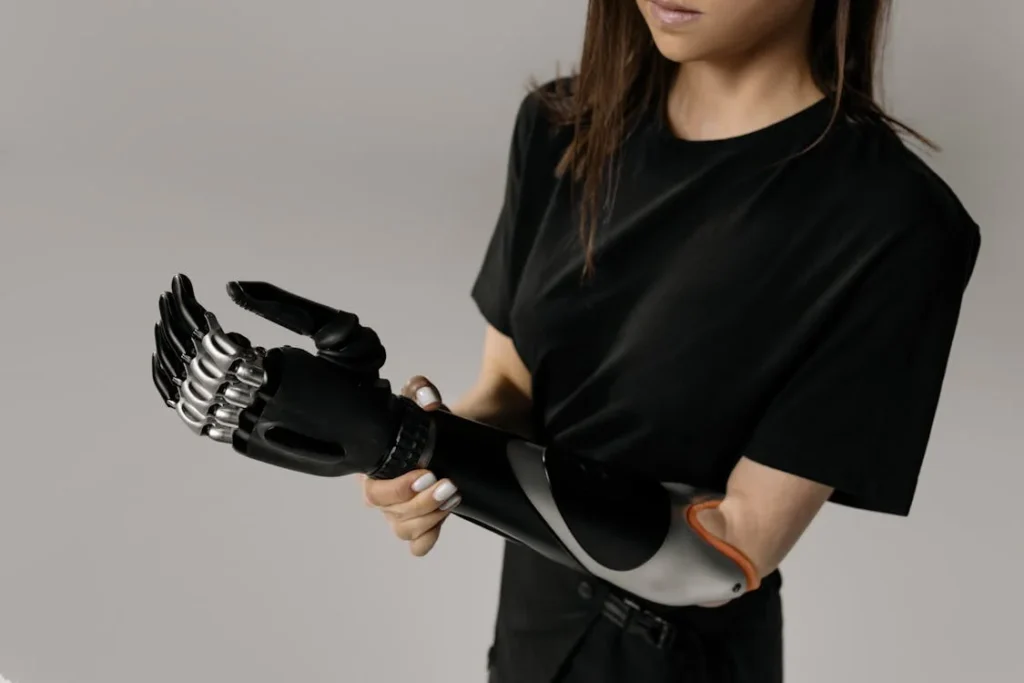
Bionic Grips and Remote Work: A New Frontier for Inclusion and Flexibility
How Remote Work Creates New Opportunities for Bionic Grip Users
In the last few years, remote work has become more than a temporary solution—it’s a lasting shift in how people engage with their jobs. For individuals using bionic grips, this shift has created unique advantages and new ways to thrive professionally.
While earlier conversations around workplace re-entry focused mostly on physical spaces—desks, tools, accessibility—remote work flips that model. Now, the home becomes the workplace. And that opens up an entirely new dimension of independence.
With a responsive bionic grip, users can now perform many of their professional tasks from the comfort and control of their own homes. This isn’t just convenient—it removes barriers. There’s no daily commute, no struggle with public transportation, and no need to navigate inaccessible buildings. That means less physical fatigue and more energy available for actual work.
At Robobionics, we’ve seen firsthand how users who once hesitated to return to office settings found renewed purpose through remote roles. With the help of adaptive keyboards, voice tools, and a functional bionic hand, they’ve been able to dive into client calls, manage spreadsheets, design graphics, write reports, and lead teams—all from home.
Creating a Personal Workspace That Works for You
Remote work gives bionic grip users complete control over their setup. Unlike traditional office environments, which may be rigid or slow to accommodate specific needs, a home workspace can be customized instantly.
A user can adjust chair height, lighting, device positions, and even temperature to stay comfortable throughout the day. Their bionic grip charging station can be within arm’s reach. Their tools—whether pens, styluses, remotes, or tablets—can be placed exactly where they’re easiest to access. This kind of personalization makes workflows smoother and reduces the need for assistance or constant adjustments.
It also fosters a sense of ownership. When users build a space that supports their prosthetic use, they take greater pride in their work. They feel like professionals, not patients. That shift in mindset boosts performance—and morale.
Increased Autonomy in Communication and Collaboration
A big part of modern work involves communication—emailing, video conferencing, project coordination. These can feel daunting to someone who’s recently re-entered the workforce after limb loss. But with the right digital tools and a reliable bionic grip, these activities become more manageable.
Using a mouse, typing with one hand while the other operates a touchscreen, holding notes while on camera—these are all made easier with bionic support. More importantly, being able to show up in virtual meetings as a capable, self-managed professional helps reshape how colleagues perceive disability.
There’s also less pressure. In video meetings, the user can control their environment, take breaks as needed, and minimize unnecessary distractions. They can engage with confidence, not fear that they’ll be physically unable to keep up.
Opening Doors to New Career Paths
Remote roles often emphasize digital skills—writing, coding, support, design, content creation, teaching, analytics. These paths don’t require heavy physical labor or constant movement. What they do require is creativity, discipline, and communication—skills that people with bionic grips often have in abundance after years of adapting, problem-solving, and rebuilding routines.
Many users discover they can explore careers they hadn’t considered before. They start freelance businesses, become virtual consultants, or take up training and mentoring roles. Because they’re no longer limited by physical office spaces or rigid workplace tools, they can pivot into work that better fits their lifestyle and strengths.
Some even find remote work less stressful socially. They feel more in control of how they’re seen and heard. Instead of being the person with the “different hand,” they’re simply a voice on the call—a contributor with valuable ideas and input.
The Importance of Self-Discipline and Ergonomics
One challenge with remote work is that it places all responsibility on the user. There’s no IT team adjusting your workstation. No ergonomics specialist checking your posture. This means bionic grip users must take the lead in maintaining their health and comfort.
This includes managing grip usage throughout the day, taking breaks to avoid strain, stretching regularly, and being mindful of battery levels and hand temperature. Some users alternate between using their grip and their natural hand to prevent fatigue. Others use smart devices to monitor muscle activity and adjust grip sensitivity.
At Robobionics, we guide users in setting up sustainable home workstations—ones that don’t just boost productivity but protect long-term health. This level of proactive care ensures that remote work remains a viable and empowering option—not a short-term fix.
Digital Inclusion and the Future of Hybrid Work
As more companies adopt hybrid work models, where employees split their time between home and office, bionic grip users stand to benefit even more. These models offer flexibility, freedom, and structure—all key to successful re-entry into the workforce.
Imagine being able to work from home three days a week and go into the office for two. On remote days, you can focus on deep work without distractions. On office days, you can collaborate in person and show the team how capable you are—not just through your words, but your actions.
This balance is what many employees are seeking now—not just people with prosthetics. And when companies create policies that support this kind of flexibility, they support inclusion at its core. They create environments where people with diverse abilities aren’t just accommodated—they’re empowered.
Conclusion
Bionic grips are not just tools—they are turning points. They help people reclaim their work lives, boost their productivity, and rebuild their confidence. Whether it’s handling physical tasks in an office or adapting seamlessly to remote work, the impact is real and lasting.
At Robobionics, we’ve seen firsthand how these devices open doors. They allow individuals to return to work stronger, more capable, and more independent than ever before. From everyday tasks to leadership roles, bionic grips empower people to thrive—not just survive—in their careers.
The future of work is inclusive, and bionic technology is leading the way. With the right support, training, and mindset, there’s no limit to what a person can achieve—one grip at a time.



